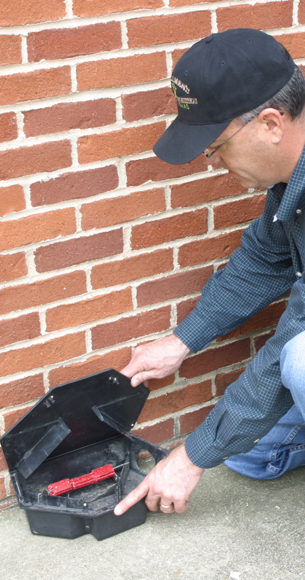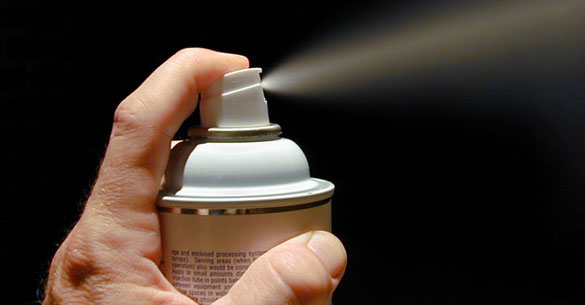Texas has one of the most comprehensive regulation programs in the nation to govern pesticide use in public schools. The program started in 1991 when the state legislature passed a bill requiring all public schools to have an Integrated Pest Management (IPM) program. Since 1995, when the school IPM statute went into effect, all public school districts in Texas must have a written pest management policy, designate and train a district IPM Coordinator, and ensure that all pesticide applications be made only by licensed applicators.
In addition to these requirements, the school pesticide regulations classify all pesticides into one of three categories based on their relative hazard. These three categories are designated either Green, Yellow or Red, where Green category products are those considered to carry the least potential hazard to people and the environment. The purpose of this classification system is to encourage schools to use the least hazardous materials needed to control pests.
The system allows any Texas school to use any pesticide they deem needed to control a pest. However, the rules require that when a Yellow or Red category pesticide is to be used, justification will first be made in writing. In addition, structural pest control service inspectors will check school records to ensure that schools do not have a practice of overusing Red and Yellow category products, when there are satisfactory Green category options.
Written justifications and approvals must be recorded and kept on file for at least three years.
Another incentive for using Green category products is that they have less restrictive application and reentry requirements. For a complete description of these requirements, and definitions of the Green, Yellow and Red categories, see the Texas Administrative Code rules for IPM in schools, Section 7.150, (d) (6.) (A-C).
There are two requirements for a pesticide to belong to the Green category. First, it must belong to EPA Category III or IV (usually identified by having a CAUTION signal word on the front panel of the pesticide label). Second, it must belong to one of the seven types of products listed below:

Any bait in a tamper-resistant container, or placed in an inaccessible location, is considered a Green category product under Texas school IPM rules.
- Low toxicity inorganic pesticides: boric acid, disodium octoborate tetrahydrate, silica gel or diatomaceous earth
- Insect growth regulators
- Insect and rodent baits in tamper-resistant containers, or for crack-and-crevice use only
- Microbe-based insecticides
- Botanical insecticides (not including synthetic pyrethroids) containing no more than 5% synergists
- Biological (living) control agents
- Pesticide soaps and oils
Yellow category pesticides are those that also bear a CAUTION signal word, but which do not fall into any of the seven types of products listed above. Red category pesticides include any pesticide that carries a WARNING or DANGER signal word. Red category products have slightly more restrictive application and reentry requirements, and require an additional signature for approval. Currently, EPA section 25(b) [exempt] pesticides and EPA-classified reduced risk pesticides are not explicitly part of the Green classification system; however, if such products meet both requirements listed above for Green category classification, they can be considered Green.
Identifying Green Category Products
Distinguishing Green products is not always easy. There is no packaging or label designation on most products. Even pesticide distributors and sales personnel are often unfamiliar with which products fall under Texas Green Category designation. For this reason we have developed the following (unofficial) list of common pesticides that fall into the Green category. This listing does not include all Green products, but is intended as a guide to the most commonly used active ingredients, and some current trade names associated with these active ingredients. Trade names change frequently. For this reason, schools and pest management professionals should focus on learning the qualifying criteria for Green Category products, rather than depending on a listing of trade names.
Examples of Green Category Active Ingredients and Trade names
| Type of Pesticide[i] | Qualifying active ingredient | Product Name(s)[ii] |
| Low-toxicity inorganics | ||
| I | boric acid (Orthoboric acid) | Borid®, Mopup®, Advance™ Liquid Ant Bait, Drax® Liquidator™ Ant Bait, Drax® Ant Kil Gel, Drax® Roach Assault PGF, Nibor-D®, Roach-Prufe®, Eaton’s Answer® Boric Acid Insecticidal Dust, InTice roach bait, InTice granular bait, Niban FG, BorActin insecticide powder, Provaunt® , Pro-Joe® ant bait |
| I, F | disodium octoborate tetrahydrate | Timbor™, Bora-Care®, NiBor-D®, Uncle Albert’s Ant Bait, Ant Café, Gourmet Ant Bait Gel, Boracide® , MopUp® |
| I | diatomaceous earth | Organic Solutions, Pyatomaceous Insecticide Dust, Diatect V, MotherEarth D Pest Control Dust, Eaton’s KOI System, Concern® |
| I | silica aerogel | PT® Tri-Die® |
| I | sodium tetraborate decahydrate (Borax) | Terro™ PCO Liquid ant bait, InTice ant gel, InTice Liquid ant bait, |
| I | pentahydrate Borax | BoracideTM borate powder |
| Insect Growth Regulators | ||
| I | cyromazine | Citation® |
| I | fenoxycarb | Logic® and Award® Fire Ant Baits, Precision™ |
| I | halofenozide | Mach-2™ Granular Turf Insecticide |
| I | hydroprene | Gentrol® IGR Concentrate, Gentrol® Point Source, Gentrol® Aerosol |
| I | methoprene | Precor® IGR Concentrate, Altosid® Mosquito Briquets |
| I | pyriproxifen | Distance®, Nylar®, Archer® |
| I | tebufenozide | Confirm® |
| Baits – Must be in a Tamper Resistant container | or crack & crevice placement | |
| I | avermectin | PT® Avert® Cockroach Bait Stations, Advance 360A Dual Choice Ant Bait Stations |
| I | boric acid | Advance™ Liquid Ant Bait, Niban® Granular Bait, Drax, Uncle Albert’s Ant Gel, |
| I | fipronil | Maxforce® FC Roach Killer Bait Gel, Maxforce® FC Ant and Roach Bait Stations, Maxforce® Carpenter Ant Bait Gel |
| I | hexaflumeron, noviflumeron | Hexpro®, Recruit® Termite Bait, Sentricon® AG III |
| I | hydramethylnon | Amdro® Pro Fire Ant Bait, Siege® Pro Fire Ant Bait, Siege® Gel Insecticide, Eclipse® Professional Insect Bait, ProBait™ Professional Fire Ant Bait, Maxforce® Granular Insect Bait |
| I | imidacloprid | Pre-Empt™ Professional Cockroach Gel Bait, |
| I | indoxacarb | Advion® cockroach gel bait, Advion® cockroach bait arena, Advion® ant gel bait, Advion® ant bait arena |
| I | acetamiprid | Transport™ roach bait |
| I | dinotefuran | Advance Cockroach gel bait® |
| I | methoprene | Pharorid® Ant Growth Regulator, Extinguish Fire Ant Bait |
| I | pyriproxifen | Distance® Fire Ant Bait |
| I | sulfluramid | Firstline™ Termite Bait Stations, Raid® Ant and Roach Controller II, Advance® Dual-Choice™ Ant Bait Stations, FluorGuard™ Ant Control Baits |
| I | thiamethoxam | Optigard Ant Gel Bait |
| R | brodifacoum | Final Blox, WeatherBlock XT, |
| R | bromadiolone | Contrac® All-Weather Blocks, Maki® Paraffin Blocks, Just One Bite® Rat & Mouse Bait |
| R | bromethalin | Top Gun™ All-Weather Bait Block, Fastrac™ Blox |
| R | chlorophacinone | Rozol® Paraffin Blocks |
| R | difethialone | Generation® Mini-blocks |
| R | diphacinone | Ditrac® Blox, Liqua-Tox®, JT Eaton® Bait Block® Rodenticide |
| Microbe-based[iii] | ||
| I | avermectin-B, abamectin | PT® Avert®, PT® Ascend™ , Advance 375A Select Granular Ant Bait, Advance Granular Ant Bait, Advance Granular Carpenter Ant Bait, Avid Insecticide, Vendetta Cockroach Gel Bait |
| I | Bacillus sphaericus | VectoLex® |
| I | Bacillus thuringiensis | Dipel®, Bactimos® Briquets, Gnatrol®, Aquaboc®, Mosuito Dunks® , Teknar® |
| I, B | Beauveria bassiana | Naturalis®-O |
| I | Microbial-based drain cleaners | DrainGel® , InVade Bio Foam® |
| I | spinosad | Conserve™ SC, Eliminator® |
| Botanicals | ||
| I | 2 phenylethyl proprionate and pyrethrins | EcoPCO® D•X – Dust Insecticide, EcoPCO® AR•X – Multi-Purpose Residual Aerosol Insecticide |
| I | 2 phenylethyl proprionate, thyme oil, pyrethrins | EcoPCO WPX |
| I,F | azadirachtin | Azatin®, Neemix™, Triact™ |
| I | Clove oil, cinnamon oil, cedar oil | Snake Out Snake Repellent |
| H | Citric Acid, Clove Leaf Oil, Cinnamon Oil |
Weed-A-Tak Organic Herbicide |
| I, H | d-limonene | Demize, ProCitra-DL, MotherEarth Wasp & Hornet Jet Spray, Organic Weed & Grass Killer |
| I | eugenol, 2 phenylethyl proprionate | Eco PCO® AC, EcoPCO® JET•X – Wasp & Hornet Jet Aerosol, EcoPCO® ACU – Unscented Contact Aerosol Insecticide |
| I | pyrethrins (pyrethrum) | CB-38 Extra™, PT® Inspector®, PT® Microcare®, Diatect Indoor Insect Killer, MotherEarth 2% Py Contact Insecticide, P.I. Contact Insecticide |
| I | Rosemary Oil, peppermint oil, oil of wintergreen, vanillin | EcoExempt IC2 |
| Biological insecticides | ||
| I, B | Entomopathogenic nematodes (Steinernema) | Biovector®, Millenium® biological, Nematac® |
| Pesticidal soap and natural and synthetic horticultural oils | ||
| I | Potassium salts of fatty acids | Safer’s Insectidical Soap |
| I | Petroleum oil- foliar spray | PureSpray Green Organic Horticultural Spray Oil |
| I, F | Highly refined paraffinic oil | Ultra-Fine Oil All Season Horticultural Insecticide/Miticide/Fungicide |
[i]. I=Insecticide, R=Rodenticide, F=Fungicide, B=Biological (living) pesticide, H=Herbicide
[ii]. Trade names and active ingredients associated with trade names change frequently. You should check with your local pest control distributor and with the pesticide label to confirm that the active ingredients match up with an approved Green Category category. Mention of trade names does not imply endorsement of a products, but is included for educational purposes only.
[iii]. The most common microbial insecticides derive their killing power from proteins or other toxins produced by microorganisms. The microbe-based pesticides listed here include those that consist not just of living or dead microbes, but also natural compounds derived from microorganisms. Spinosad, for example, consists of an insecticide produced naturally by the Actinomycete, Saccharopolyspora spinosa. These pesticide active ingredients generally display a high degree of selectivity for insects.
For More Information
For more information about IPM in schools and childcare facilities, visit the Texas AgriLife Extension Service’s school IPM website at http://schoolipm.tamu.edu. You can also call the toll-free school IPM hotline at 877-747-6872.
This is not an official publication by the Texas Structural Pest Control Service. If in doubt about what constitutes a Green Category product, where and when they may be used, and how to gain approval for Yellow and Red List products in schools, contact the Texas Structural Pest Control Service directly. Texas Department of Agriculture, Structural Pest Control Service, 1700 N. Congress, Austin, TX 78701 Phone: (512) 305-8250 or toll free (866) 918-4481 www.tda.state.tx.us/spcs
Authors:
Michael Merchant, Professor and Extension Urban Entomologist, and Janet Hurley, Extension Program Specialist for School IPM, Texas AgriLife Extension Service
